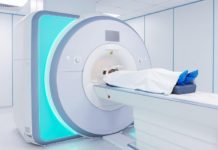Atherosclerosis, more commonly known as arterial clogging, is the most widespread disease in most nations of the world. In a recent presentation at the Scientific Sessions of the American Heart Association meeting in Orlando, Fla., an international research team has documented that the people of antiquity suffered from clogged arteries, as well. Through the use of a SOMATOM® Emotion 6 computed tomography (CT) scanner from Siemens Healthcare, the team discovered the atherosclerosis in Egyptian mummies as old as 3,500 years.
For four days, the team of cardiologists examined 20 mummies from the Museum of Egyptian Antiquities in Cairo under the guidance of the Drs. Gregory Thomas and Adel Allam, co-principal investigators on the study. Two previously scanned mummies (same conditions, same purpose) were additionally included into the analysis. They worked in conjunction with an expert Egyptian archeology team. The researchers wanted to know if people living in antiquity had healthier vessels than we do today. One important requirement was that the “study subjects” could not be injured during the examination. For this reason, Siemens sponsored the study and supported image pre-processing with on-site technical consultancy. Due to its size, the scanner could be put in a trailer, placed right next to the Cairo Museum, which made logistics really smooth and easy.
The research team concentrated on the use of radiography of arterial vessels. In contemporary humans, blood lipids frequently accumulate in these vessels leading to a blockage of the blood flow. To their surprise they found that nine of the16 mummies in which they were able to identify blood vessels had calcium deposits in their artery walls, suggesting that they suffered from arterial clogging, a disease that can cause heart attacks and strokes. Atherosclerosis did not spare women. Vascular calcifications were observed in both male and female mummies. The individuals lived between 1570 BCE and 364 CE. For the ones that identity could be determined – which was most – all enjoyed elevated social status.
“We combined the science which they developed 3,500 years ago with the 21st century technology of a high precision instrument, the Siemens SOMATOM Emotion 6-slice configuration CT scanner, and were able to learn about health and disease across the ages,” said Dr. Randall Thompson, professor of medicine at the University of Missouri-Kansas City School of Medicine. “The mummies have portions of the cardiovascular system intact, which were clearly recognizable. On these CT scans, the atherosclerosis looks just like it does in my modern-day patients. The technology allowed us to discover that this disease has afflicted humans since before the time of Moses and is giving us insights into modern human health. We are able to achieve these insights without disturbing the remains of these people who walked the earth such a long time ago.”
While we do not know whether atherosclerosis caused the demise of any of the mummies in the study, we can confirm that the disease was present in many. It obviously was rather common in ancient Egyptians of high socioeconomic status living as much as 3,500 years ago,” said Thomas, a clinical professor of cardiology at the University of California Irvine. “The findings suggest that we may have to look beyond modern risk factors to fully understand the disease.”
Drs. Samuel Wann (Wisconsin Heart Hospital) and Michael Miyamoto (University of California, San Diego) completed the cardiology team. The archeology team was led by Dr. Abd el-Halim Nur el-Din (Cairo University) with Drs. Gomaa Abd el-Maksoud (Cairo University) and Ibrahem Badr, (Institute of Restoration, Alexandria). Drs. Hany Abd el-Amer (National Research Center, Giza) and Jennifer Thomas (Massachusetts General Hospital) provided CT scanning and statistical support, respectively.
Study results appeared in the Nov. 18 issue of the Journal of the American Medical Association (JAMA) and were presented Nov. 17 at the Scientific Session of the American Heart Association at Orlando, Fla.
In addition to Siemens Healthcare, the study team also received support from the National Bank of Egypt and St Luke’s Hospital Foundation, Kansas City, Mo.
The Siemens Healthcare Sector is one of the world's largest suppliers to the healthcare industry and a trendsetter in medical imaging, laboratory diagnostics, medical information technology and hearing aids. Siemens offers its customers products and solutions for the entire range of patient care from a single source – from prevention and early detection to diagnosis, and on to treatment and aftercare. By optimizing clinical workflows for the most common diseases, Siemens also makes healthcare faster, better and more cost-effective. Siemens Healthcare employs some 48,000 employees worldwide and operates around the world. In fiscal year 2009 (to September 30), the Sector posted revenue of 11.9 billion euros and profit of around 1.5 billion euros. For further information please visit: www.siemens.com/healthcare.























